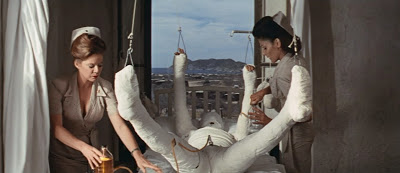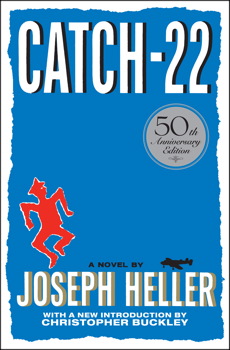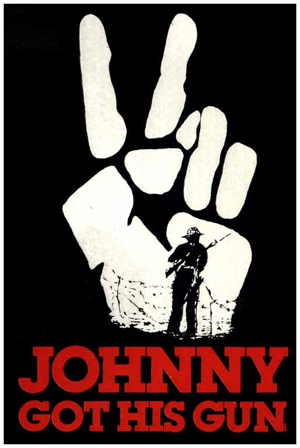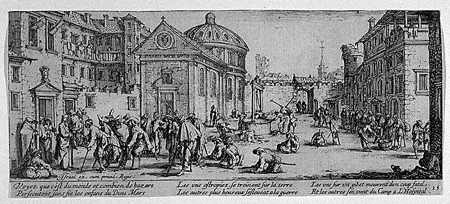
I recently had to go into hospital for bladder surgery and had to stay an extra night as I had bleeding and blood clots. I was hooked up to a diabolical hydraulic machine which pumped 66 liters of saline in and out of my bladder for a day and a half to “irrigate” it. Though I would have to say it was more “irritation” than ”irrigation”. I was woken up every hour or so throughout the night when the nurse hung up new bags of saline.
It made me think of the powerful scene in Mike Nichols’ film of Joseph Heller’s novel Catch 22 (1961) where two nurses attend a poor bloke in a military hospital who is encased in a full body cast and casually swap the bag of saline and the urine bag instead of giving him a fresh one. All without so much as breaking their inane conversations about something or other. The thought of this happening to me gave me nightmares. So I returned to Heller’s novel to refresh my memory.

The copy I had in the 1970s broke its spine, was surgically repaired, but eventually got lost in one of my moves over the years. I got a new one (the 50th anniversary edition). I remember reading the novel when I was in high school and sneaked in to see the film when it was released. It was 1971 or thereabouts and I was 14 and the film was rated “adults only” by the censors (which are quite strict in Australia). It had a deep impact on me.
The saline swapping scene comes from chapter 17 “The Soldier in White”. Here Heller considers the different ways of dying in a hospital compared to the many terrible ways one can die in battle (in his case in the air in a bomber). See for example this passage:
Being in the hospital was better than being over Bologna or flying over Avignon with Huple and Dobbs at the controls and Snowden dying in back.
There were usually not nearly as many sick people inside the hospital as Yossarian saw outside the hospital, and there were generally fewer people inside the hospital who were seriously sick. There was a much lower death rate inside the hospital than outside the hospital, and a much healthier death rate. Few people died unnecessarily. People knew a lot more about dying inside the hospital and made a much neater, more orderly job of it. They couldn’t dominate Death inside the hospital, but they certainly made her behave. They had taught her manners. They couldn’t keep Death out, but while she was in she had to act like a lady. People gave up the ghost with delicacy and taste inside the hospital. There was none of that crude, ugly ostentation about dying that was so common outside the hospital. They did not blow up in mid-air like Kraft or the dead man in Yossarian’s tent, or freeze to death in the blazing summertime the way Snowden had frozen to death after spilling his secret to Yossarian in the back of the plane. …
They didn’t take it on the lam weirdly inside a cloud the way Clevinger had done. They didn’t explode into blood and clotted matter. They didn’t drown or get struck by lightning, mangled by machinery or crushed in landslides. They didn’t get shot to death in hold-ups, strangled to death in rapes, stabbed to death in saloons, bludgeoned to death with axes by parents or children, or die summarily by some other act of God. Nobody choked to death. People bled to death like gentlemen in an operating room or expired without comment in an oxygen tent. There was none of that tricky now-you-see-me-now-you-don’t business so much in vogue outside the hospital, none of that now-I-am-and-now-I-ain’t. There were no famines or floods. Children didn’t suffocate in cradles or iceboxes or fall under trucks. No one was beaten to death. People didn’t stick their heads into ovens with the gas on, jump in front of subway trains or come plummeting like dead weights out of hotel windows with a whoosh!, accelerating at the rate of thirty-two feet per second to land with a hideous plop! on the sidewalk and die disgustingly there in public like an alpaca sack full of hairy strawberry ice cream, bleeding, pink toes awry.
Yossarian was trying to avoid doing more dangerous and deadly flying missions so he took refuge in the hospital. He was thus able to observe the treatment the “soldier in white” was getting, such as the “polishing” of his bandages and the swapping over of his saline and urine bags:
The soldier in white was more like a stuffed and sterilized mummy than a real nice guy. Nurse Duckett and Nurse Cramer kept him spick-and-span. They brushed his bandages often with a whiskbroom and scrubbed the plaster casts on his arms, legs, shoulders, chest and pelvis with soapy water. Working with a round tin of metal polish, they waxed a dim gloss on the dull zinc pipe rising from the cement on his groin. With damp dish towels they wiped the dust several times a day from the slim black rubber tubes leading in and out of him to the two large stoppered jars, one of them, hanging on a post beside his bed, dripping fluid into his arm constantly through a slit in the bandages while the other, almost out of sight on the floor, drained the fluid away through the zinc pipe rising from his groin. Both young nurses polished the glass jars unceasingly. They were proud of their housework.
And further:
Nurse Duckett showed up then and chased them all back to their own beds while Nurse Cramer changed the stoppered jars for the soldier in white. Changing the jars for the soldier in white was no trouble at all, since the same clear fluid was dripped back inside him over and over again with no apparent loss. When the jar feeding the inside of his elbow was just about empty, the jar on the floor was just about full, and the two were simply uncoupled from their respective hoses and reversed quickly so that the liquid could be dripped right back into him. Changing the jars was no trouble to anyone but the men who watched them changed every hour or so and were baffled by the procedure.
“Why can’t they hook the two jars up to each other and eliminate the middleman?” the artillery captain with whom Yossarian had stopped playing chess inquired. “What the hell do they need him for?”
“I wonder what he did to deserve it,” the warrant officer with malaria and a mosquito bite on his ass lamented after Nurse Cramer had read her thermometer and discovered that the soldier in white was dead.
“He went to war,” the fighter pilot with the golden mustache surmised.
It was interesting to see how my nurses referred to these bags of saline and urine. They would hold up the urine bag against the light and earnestly discuss its colour using simile’s taken from oenology, such as “rosé”. I would imagine that “claret” was not a good sign (probably indicating the end was nigh), “rosé” was the word they used at first and this kind of wine was a cause for concern. Success would be declared when the “rosé” was miraculously transmogrified into “chardonnay” in a kind of reverse biblical miracle of turning wine into “water.” All of this of course was taking place in a strict prohibitionist environment where wine of any variety was kept away from my thirsting lips, so talking about it seemed a bit cruel.
Mike Nichols’ film of Catch-22 was a war film I showed my students many times when I was teaching a course called “Responses to War: An Intellectual and Cultural History” at the University of Adelaide. You can see the film guide I wrote for it here. There was also a major theme in the course on how those who experienced or witnessed military hospitals dealt with it in their creative work such as art (Jacques Callot), novels (Erich Maria Remarque’s All Quiet on the Western Front (1928), Dalton Trumbo’s Johnny Got his Gun (1938, the movie based on the novel appeared in 1971 the year after Nichol’s film on Catch-22), and Heller of course), or eye witness accounts (Florence Nightingale of the Crimean War and Henri Dunant of the Battle of Solferino).

A most depressing view of an army “hospital” was given by the 17th century French engraver Jacques Callot (1592-1635) in his series on “The Miseries of War” about the Thirty Years War. This one is called “The Hospital”

which shows the courtyard of a so-called “hospital”. Those maimed and crippled by war make their way to the entrance lower left where they are met by a priest/doctor. In the Centre is a well next to which is a tub for washing. Cripples are doused with water. To the Right a line of maimed receiving food from a large pot.
See Jacques Callot (1592-1635) and the Miseries of the Thirty Years War which is part of a series on War and Art.
